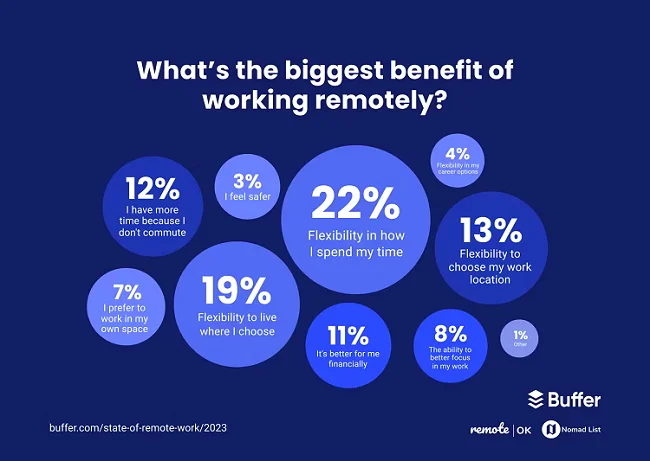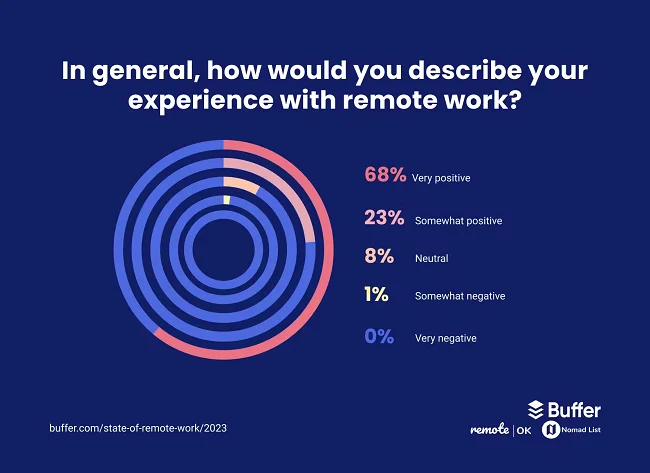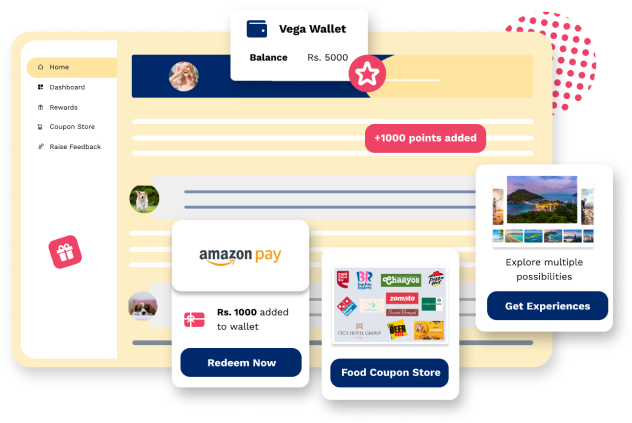Lack of team bond. Time zone disparities. Difficulty in monitoring productivity. These are a few common challenges of handling a team. As a manager, overseeing remote or hybrid teams adds an extra layer of complexity to these challenges.
Effectively managing remote or hybrid teams is no simple task. Unspoken concerns and incomplete tasks can lead to missed project deadlines and hinder team success.
However, the good news is that there are proven strategies that you can deploy to enhance the effectiveness of remote work policy. But, before we dive into the strategies, let’s get started from the top!
What is Remote/Hybrid Work Policy?
According to a survey, 87% of people said they would prefer a flexible work schedule if offered. Also, by 2028, it is expected that 73% of all departments will allow remote work.
Interesting, isn’t it?
With this in mind, it’s best to be prepared with a remote/hybrid work policy. But what is it? What does it comprise? Let’s find out!
A remote/hybrid work policy is a modern work structure where flexibility is of prime importance. The policy outlines guidelines for employees either working completely from home or splitting their time between traditional office spaces and remote locations.
It's a strategic roadmap that fosters collaboration, productivity, and work-life balance. By defining expectations, communication channels, and technology protocols, it ensures a seamless fusion of in-person and virtual work experiences. Based on the spirit of adaptability, a well-crafted remote/hybrid work policy empowers teams to excel with flexible work arrangements.
Why create a transparent hybrid/remote work policy?
- It promotes inclusivity by providing equal opportunities for both on-site and remote employees.
- It addresses legal and compliance issues related to remote work, such as tax implications and labor laws.
- It acts as a framework for swift decision-making and communication during emergencies/crisis management.
Benefits of Hybrid/Remote Work
Here is a table outlining the benefits of a hybrid remote work policy for both employees and employers.
Benefit for Employees
| Benefit for Employers
|
Employees can enjoy more flexibility with a better balance of work and personal commitments, leading to improved well-being.
| Employers can enjoy a global talent pool and tap into a diverse set of skills and perspectives.
|
The hybrid remote setting helps in cost-saving as employees save significantly on commuting, work attire, and meals, contributing to increased disposable income.
| Flexible work arrangements enable higher productivity as happier employees contribute to better overall performance.
|
It helps reduce commuting stress and prevent burnout. This helps improve mental health and leaves one to engage in personal activities.
| Employers can save significantly on office space and other overhead costs associated with working out of a physical workspace.
|
Hybrid remote work allows employees to have more control over where they choose to work, leading to higher job satisfaction.
| One of the key benefits of remote and hybrid work is that it acts as a competitive advantage in attracting and retaining top talent.
|
Here is what Buffer found with their latest survey:

Source:buffer
According to this, flexibility remains the top benefit of remote work. Among the surveyed individuals, 22% value remote working primarily for the flexibility it offers in managing their time, while 19% appreciate the freedom to choose their place of residence. Additionally, 13% cite the ability to decide their work location as a significant advantage.
These benefits are exceptional. However, opting to go for hybrid remote working within the company can be difficult and full of roadblocks. Let’s take a look at some strategies that can help you kick off a hybrid remote work structure confidently.
Strategies for Creating an Effective Hybrid Remote Work

Source:buffer
According to the above survey, 68% are positive about the hybrid remote work. To maintain and improve this number, there are some proven ways for your path to success. Take a look!
1. Ensure Smooth Onboarding
Creating a seamless onboarding process is key to establishing a successful hybrid remote work environment. As new team members join remotely, it's crucial to provide them with comprehensive resources, clear guidelines, and virtual introductions to facilitate a swift integration into the team. Begin by digitizing the onboarding documentation, ensuring accessibility from any location. This not only saves time but fosters a sense of inclusivity, making remote employees feel valued from day one.
To further enhance the onboarding experience, consider assigning a virtual mentor or buddy to guide new hires through the remote company culture and work. Encourage regular check-ins between mentors and mentees, creating an open channel for questions and support.
Moreover, organize virtual orientation sessions, offering insights into company values, expectations, and collaboration tools. Utilize interactive elements such as virtual office tours or team-building exercises to cultivate a collaborative atmosphere, despite the physical distance.
Following these strategies will ensure that every team member feels connected, supported, and ready to contribute to the organization's success.
Are you Ready to Enhance your Employee Experience?
With Vega HR, foster a work culture that brings the best out of your employees by creating the most positive and uplifting environment
2. Establish Clear-Cut Communication Guidelines
To ensure transparent communication within the organization, establish a comprehensive remote work policy, defining communication channels, and team structures. Specify the preferred mediums for communication, whether it be email, instant messaging, or video conferencing, alongside expected response times. Encourage regular check-ins and schedule frequent one-on-ones for addressing questions and providing guidance. By leaving no room for ambiguity, teams can bridge the physical distance seamlessly.
However, effective communication goes beyond formal channels; it necessitates the cultivation of team cohesion. Without face-to-face interactions, planning team activities and initiatives becomes paramount. These not only act as a welcome respite from the virtual grind but also act as fuel for building camaraderie among team members. For instance, implementing a virtual coffee break routine or a bi-weekly team-building exercise can be instrumental in enabling a sense of belonging.
3. Set Benchmarks for Evaluating Performance
Workers joining remotely might shy away from seeking clarifications or voicing concerns. Unlike the ease of swiveling in an office chair to address a query, online interactions demand a deliberate act, potentially hindering their ability to grasp work faster and may even impact their productivity.
To counteract this, it is important to integrate clear benchmarks for performance assessment right from the commencement of the remote work arrangement. Regular feedback is mandatory. Seek insights into the individual’s adaptation process. This way, leaders can proactively address challenges, foster a sense of belonging, and smoothen the integration of remote workers into the team and company culture.
For instance, some employees like taking feedback very frequently, while others might hesitate to reach out for assistance due to the perceived digital barrier. In such cases, having a well-defined performance benchmark process that encourages open communication can bridge this gap, allowing the individual to seek feedback promptly and ensuring that productivity remains unhindered.
4. Create Flexibility Within the Structure
Adapting hybrid remote work as an organization involves recognizing and accommodating the diverse needs of individuals seeking flexibility in their work environments. Also, studies consistently emphasize that staying laser-focused on tasks for an hour followed by a brief break sustains optimal productivity levels, helping you get back to work with renewed energy and enthusiasm.
To instill flexibility within the structure, instead of rigid schedules, define a core window where everyone is expected to be available for collaborative discussions. This not only accommodates diverse time preferences but also guarantees a designated timeframe for seamless communication and issue resolution. Striking this balance prevents potential hiccups or delays, ensuring a cohesive workflow.
Imagine a marketing team where members are spread across different time zones. Instead of waiting for meetings to put their points, they utilize collaborative tools like Slack and project management platforms. This allows team members to contribute at their own pace, promoting productivity and work-life balance. This flexible structure ensures effective communication without compromising individual preferences or time constraints.
5. Create a Rewarding Culture with Trust
Building a rewarding culture in remote and hybrid work settings relies on trust. As a manager, your commitment to fairness and inclusive decision-making plays a key role in fostering this trust.
Utilize tools like Vega HR to publicly recognizing and appreciating team members on the social intranet. Measure employee sentiment and gather continuous feedback through eNPS, polls, and quizzes to create a positive atmosphere, reinforcing trust within the dispersed team. This two-way communication, coupled with transparent decision-making, not only clarifies the rationale behind choices but also nurtures a healthy company culture. By prioritizing trust through recognition, surveys, and inclusive practices, you're laying the foundation for a successful and fulfilling remote and hybrid work experience.
As a hybrid remote company, you'll likely encounter varying challenges on an ongoing basis. It's essential to stay composed amidst these challenges, consistently reviewing and updating policies to ensure adaptability and effectiveness.
Wrapping Up
So, these are the top strategies that you can adopt within the organization. Several well-known companies, including Twitter, Google, and Microsoft, represent the widespread adoption of hybrid and remote work models. Microsoft, for instance, promotes a hybrid work model, highlighting that employees will have the flexibility to work both remotely and in the office. Also, Sundar Pichai, CEO of Google, expresses enthusiasm about the prospect of a flexible future of work.
Indeed, the future of work appears to lean towards a hybrid and remote model, aiming to attract and retain top-notch employees for the long term.
And, equipped with the above-mentioned strategies, you too can ace the evolving work model successfully.
About Vega HR
Vega-HR is a powerful tool in the talent war, offering employee rewards, recognition, and pulse recognition. With an engaging platform, it fosters a world-class work culture, providing P2P recognition, social feedback, on-spot recognition, and monetizable incentive solutions with 3000+ coupons in various categories.
Create a Culture People Want to Stick to
- Send rewards
- Give shoutouts
- Build a community
- Gift experiences
Get a demo
 Written by Shubhika Sundriyal 05 March 2024 | 4 min read
Written by Shubhika Sundriyal 05 March 2024 | 4 min read





